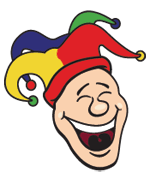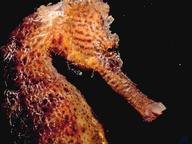FREE! Click here to
Join FunTrivia. Thousands of games, quizzes, and lots more!

Seahorses Trivia Questions and Answers
Fun Facts & Interesting Information
Fun Trivia Question Usage
You are welcome to use the questions in this section for non-commerical purposes: quizzing friends/coworkers, classrooms, newsletters, trivia nights, events, etc. Questions may
not be used for websites or in apps, and may not be resold. You use the questions at your own risk, and FunTrivia is not responsible for errors, etc in the content.
Please
link to or
credit FunTrivia textually (http://www.funtrivia.com) if you use any of these questions. Thanks!
Visit our
Trivia Question Store to buy question packs for commercial or for-profit ventures.
1. The name "seahorse" comes from the fact that they live in the sea and look like they have the head of a horse. Seahorses are members of the genus Hippocampus, which is a combination of Greek words meaning what?

Answer: horse monster
Interesting Information:Poseidon was the Greek god of the sea and of horses, so a mixture of the two was inevitable. In mythology, the hippocamp (or hippocampus) is depicted as having the front of a horse and a long, coiling, fish tail.
"Hippopotamus" means "river horse".
Difficulty: Hard.
From Quiz: Simply Seahorses
Some incorrect choices:
sea horse, horse fish, river horse
2. There are about 50 species of seahorses currently recognised. In which region are the greatest number of species found?
Answer: Indo-Pacific
Interesting Information:Australia has at least 14 species and Japan has at least 7 species.
Difficulty: Hard.
From Quiz: Seahorses - Amazing and Beautiful
Some incorrect choices:
South Pacific, Atlantic, Mediterranean
3. Seahorses are members of the genus Hippocampus. Even if you do not own a seahorse, you do have a hippocampus. Where is it?
Answer: brain
Interesting Information:The name for the hippocampus is attributed to Julius Caesar Aranzi (1529/1530 - 1589), an anatomist, because this part of the brain looks like a seahorse. It is involved with memory, spatial memory, and navigation.
The fund-raising mascot for the National Society for Epilepsy (UK) is Caesar the Seahorse, because the hippocampus is usually affected during epilepsy. Caesar the Seahorse is named for the Roman Emperor, Julius Caesar (who had epilepsy), not for the anatomist Julius Caesar Aranzi who named the hippocampus.
Difficulty: Hard.
From Quiz: Simply Seahorses
Some incorrect choices:
kidney, lung, stomach
4. Seahorses belong to the Syngnathidae family of fish which also include:
Answer: Pipefish, Pipehorses and Seadragons
Interesting Information:Syngnathidae (pronounced sing-nath-i-day) comes from the Greek words "syn" - together; and "gnathus" - jaws or snout. Seahorses belong to the genus, Hippocampus from the Greek words "hippos" - horse and "campos" - monster.
Difficulty: Hard.
From Quiz: Seahorses - Amazing and Beautiful
Some incorrect choices:
Trumpetfish, Stingrays and Hornfish, Trumpetfish, Sticklebacks and Boxfish, Mudskippers, Seadragons and Stonefish
5. Seahorses have a tail that curls forward - what do they use their tail for?
Answer: grabbing
Interesting Information:Seahorses use their prehensile tails to anchor themselves in place and for courtship.
Males will also "tail-wrestle" to exert dominance.
Difficulty: Hard.
From Quiz: Simply Seahorses
Some incorrect choices:
swimming, communication, attracting food
6. What do you call baby seahorses?
Answer: Fry
Interesting Information:Young fry are also called "ponies". Depending on the species and the size of the parents, 5 to 1600 fry can be produced.
Difficulty: Hard.
From Quiz: Seahorses - Amazing and Beautiful
Some incorrect choices:
Foals, Rotifers, Brine
7. What internal structure does the seahorse lack?
Answer: stomach
Interesting Information:Seahorse eat constantly to help get enough food to digest
Difficulty: Hard.
From Quiz: Those Amazing Seahorses
Some incorrect choices:
bones, liver, kidney
8. What is the interesting feature of a male seahorse?
Answer: The male incubates the eggs in his pouch and gives birth to live young
Interesting Information:The female lays her eggs into the male's pouch where they are fertilised, incubated and he gives birth to live young.
Difficulty: Average.
From Quiz: Seahorses - Amazing and Beautiful
Some incorrect choices:
After fertilisation, the female lays her eggs in the sand and abandons them - leaving the male to protect the eggs and rear the young., The male lays the eggs, The male creates an "incubation bubble" for the female to lay her eggs into.
9. All these fish are related to the seahorse except...
Answer: Pork Fish
Interesting Information:The other three are related due to the fused jaws.
Difficulty: Hard.
From Quiz: Those Amazing Seahorses
Some incorrect choices:
Pipefish, Trumpetfish, Snipe Fish
10. How do seahorses regulate their buoyancy in the water?
Answer: They have an inflatable bladder
Interesting Information:Seahorses have a skeleton made up of bony plates. They use their gills to breathe and have an inflatable bladder to help regulate their buoyancy in the water.
Difficulty: Hard.
From Quiz: Seahorses - Amazing and Beautiful
Some incorrect choices:
They use their prehensile tails, They must remain in constant motion, They have a secondary set of gills
11. Which fact about the seahorse is false?
Answer: Are a favorite food supply for most fish
Interesting Information:Actually, some fish will eat seahorses, however, most will not because they are very bony with little meat on them.
Difficulty: Hard.
From Quiz: Those Amazing Seahorses
Some incorrect choices:
Each eye moves independently, Range from inch to about a foot or more in size, They have no teeth
12. The pectoral fins of a seahorse are located...
Answer: On each side of the head (imagine where ears might be)
Interesting Information:The pectoral fins are used for propulsion and are located on either side of the head.
Difficulty: Hard.
From Quiz: Seahorses - Amazing and Beautiful
Some incorrect choices:
On either side of their dorsal fin, At the base of their anal fin, On each side of the chest area (imagine where shoulders might be)
13. Hippocampus erectus is the scientific name for which seahorse?
Answer: Lined Seahorse
From Quiz: Those Amazing Seahorses
Some incorrect choices:
Dwarf Seahorse, Sea Dragon, Pot bellied seahorse
14. When keeping seahorses in a home aquarium...
Answer: Food sources must be sized according to snout size.
Interesting Information:Seahorses have no teeth; their food is sucked through their tubular snout. All food must be sized accordingly - if it is too big they will not be able to eat it, likewise large seahorses show little interest in food that is too small.
Difficulty: Hard.
From Quiz: Seahorses - Amazing and Beautiful
Some incorrect choices:
Food sources must be a minimum of 5mm, Food sources must be a minimum of 2 mm, Food sources must be sized according to abdomen size (<2%)
15. Seahorses belong to the family Syngnathidae. What does this translate to in English? (Syngnathidae comes from the Greek words syn and gnathus)
Answer: Fused jaws
Interesting Information:All of them have fused jaws, so they kind of suck up their food like a straw.
Difficulty: Hard.
From Quiz: Those Amazing Seahorses
Some incorrect choices:
Male breeders, Horse head, Armor plated
16. What is an ovipositor?
Answer: The female's egg laying organ
Interesting Information:During the courtship ritual, the female positions her ovipositor above the male's pouch for egg transfer.
Difficulty: Hard.
From Quiz: Seahorses - Amazing and Beautiful
Some incorrect choices:
Hippocampus Ovipositor - a tropical breed of seahorse, A small shrimp (crustacean), used as a food source, The device used to measure the salt content in the water.
17. Which fin does the seahorse lack?
Answer: Caudal
Interesting Information:The caudal fin is the tail fin which most fish uses for movement in the water. A seahorse's tail is more adapted for clinging on to vegetation.
Difficulty: Hard.
From Quiz: Those Amazing Seahorses
Some incorrect choices:
Dorsal, Pectoral, Anal
18. What do you call the bony growth on the top of a seahorse's head?
Answer: Coronet
Interesting Information:Coronet styles vary from breed to breed. Some have a distinctive knob-like coronet, others slope backwards, while the H.barbouri has a stylish medium coronet with five sharp spines.
Difficulty: Hard.
From Quiz: Seahorses - Amazing and Beautiful
Some incorrect choices:
Crown, Tiara, Top Hat
19. What is the biggest threat to seahorses?
Answer: use in medicines
Interesting Information:Over 20 million seahorses are caught for use in "traditional" medicine in countries such as China.
For the aquarium hobbyist, "Wild Caught", or WC, seahorses do not perform as well in captivity as "Captive Bred", or CB, seahorses. WC seahorses are also more difficult to feed, and usually insist on live food instead of freeze-dried.
Difficulty: Hard.
From Quiz: Simply Seahorses
Some incorrect choices:
aquarium hobbyists, loss of habitat, water pollution
20. Approximately how many tonnes of dried seahorses are consumed annually for the traditional Chinese medicine market?
Answer: 20 tonnes
Interesting Information:Seahorses are used in traditional medicines from many cultures to cure a variety of ailments. They are typically wild-caught, dried, and sold in pairs. The dried seahorses are ground into a powder and combined with other ingredients to form the tonic. In 1988 Australia placed all seahorses and seadragons under the Australian Wildlife Protection Act and declared their conservation status as vulnerable.
Difficulty: Hard.
From Quiz: Seahorses - Amazing and Beautiful
Some incorrect choices:
5 tonnes, 10 tonnes, 50 tonnes
21. Both the Leafy and the Weedy sea dragons are found only where?
Answer: Australia
Interesting Information:Very odd looking animals!
Difficulty: Hard.
From Quiz: Those Amazing Seahorses
Some incorrect choices:
India, Japan, South America
Please remember to credit FunTrivia.com, add links on your website or newsletters, or otherwise spread the word about our website. Thank you very much, and we hope these questions have been useful!
| 